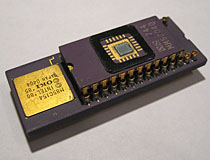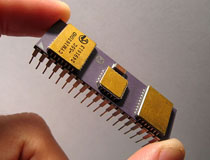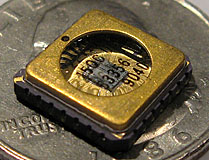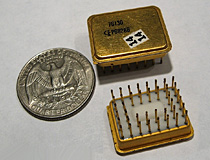
 |
| Monolithic Integrated Circuits |
Click photos to enlarge. |
|
| OKI Intel M85C154 | |
The Intel M85C154 is a special class of microprocessor known as a 'piggyback' CPU. Piggyback microprocessors are designed to act as a programming development tool and can be easily recognized by the presence of a top mounted socket. In use, the engineer would program a blank EPROM on a desktop computer with their test code, then insert the EPROM into the socket on the microprocessor so the code loaded inside could be tested. Once the code was tested and finalized, a cheaper one-time-programmable microprocessor with built in EPROM would be used in the final product. The M85C154, an 8 bit CPU based on the Intel 8051, is fairly representative of a typical piggyback microcontroller. This device has a maximum clock speed of 22MHz and 16k of onboard ROM space. Additionally, the M85C154 can address up to 64K of program ROM through it's piggyback socket.
|  |
| Cypress CYM1620 | |
The CYM620 is a 1 megabit static ram module built around several leadless ICs mounted to a ceramic carrier. Four of these chips are 256k static RAMs, with the fifth being a decoder IC. The RAM units are grouped into a high and low pair, with the decoder reading the highest position address bit to determine which pair should be active. The TTL level inputs and outputs as well as the substantial hermetic packaging and wide temperature ratings make this a fairly robust memory IC.
|  |
| Cypress 22V10 | |
The 22V10B is a tiny programmable logic array (PAL), which contains a number of logic gates whose connections can be selected electronically. This chip was manufactured in a number of different package types, the example shown here contains a prominent glass window, which allows the chip to be erased with UV light and re-used. The window covers nearly the entire top surface of the chip, forcing the part number to be printed directly on the window's surface. ICs deployed into commercially manufactured devices typically omit the window to save costs, since the chip would never need to be reprogrammed outside of the factory. The gate array inside the 22V10 is wired in a cross connected matrix and can be programmed to emulate logic systems in the range of 500 to 800 separate gates. The 22V10 also makes use of "Macro Cells" across each of it's 10 outputs, which can be switched to become additional inputs on the fly. The 22V10B shown in the photo was likely manufactured exclusively by Cypress Semiconductor.
|  |
| General Instrument P6828 | |
The General Instrument P6828B is an entirely undocumented integrated circuit. No descriptions or information appear to exist on datasheet or partminer sites, and the examples we found did not include any supporting documentation. The device itself is encased in a rectangular gold bathtub package with a white glass base and gold leads. The underside gold leads are arranged in a pin grid pattern and have a square cross-section, most likely to facilitate wire wrap installation. Unfortunately, not much else can be determined from an external examination, and this device is uncommon enough that cutting the lid off of one for a look at the internals seems like borderline heresy. If you can identify this device, please contact us. |  |
| ©2000-2024 Industrial Alchemy. All rights reserved. | Switch to mobile version | Contact | |  |